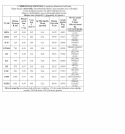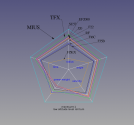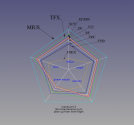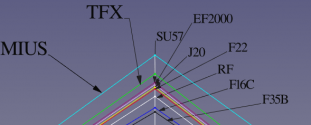You are using an out of date browser. It may not display this or other websites correctly.
You should upgrade or use an alternative browser.
You should upgrade or use an alternative browser.
Turkey Military News, Reports, Data, etc.
- Thread starter Jeff Head
- Start date
The first Turkish turbofan jet engine with 6,000 lb. thrust developed by TEI was exhibited at Teknofest in Samsun. The engine, which will be started in the first months of next year, will also have an afterburner, moving nozzle system.
Giving information about the engine, TEI General Manager Prof. Dr. Mahmut Akşit said that there was 2.5 years of engineering work on the TF6000. Stating that they have implemented many innovative systems from metal alloy technologies to the design of the engine, Mahmut Akşit said, “It takes 8-10 years to make such an engine. We took the work we started with the TJ300 to this level. The TF6000 was designed for Baykar's Combatant Unmanned Aircraft System (MIUS). It has the capacity to fly at subsonic speed, which is the first model of MİUS, with its engine propulsion.
With the addition of an afterburner section of approximately 1.5 meters for the engine, MIUS will be able to exceed the speed of sound. In the next engine model, the maneuvering capacity will be increased by directing the thrust with a moving nozzle.
Next target is the MMU
Stating that they are working for the MMU, Mahmut Akşit said, “We can make this engine sufficient for TAI's National Combat Aircraft (MMU) by expanding the states of this engine by 15 cm as the propulsion power. We have an important infrastructure for the engine with the addition of features such as low trace with stealth technologies.
Can be used for civilian purposes
With the modification to be made, the TF6000 series will also be made available for power generation or electricity generation with the help of gas turbines on ships. For this reason, it is aimed to use not only kerosene, that is jet fuel, but also diesel, natural gas or other fuels for civilian models of the engine.
Translated with Google Translate
In the next engine model, the maneuvering capacity will be increased by directing the thrust with a moving nozzle.
Although the utilities of putting a thrust vectoring engine on a plane that is already small and maneuverable are questionable, thrust vectoring for Kızılelma is confirmed.
P.S. which conops would require a stealth unmanned fighter (that is designed to engage its targets at long distances) to be super maneuverable?!
Last edited:
Mr Akşit: "The Tf6000 is actually a technological preparation for the MMU's engine. When we increase the radius of the TF6000 by 15 cm, we will have reached the level of 35000lb thrust"
Mr Akşit: "We couldn't make it to the fair, but the Tf6000 is designed with afterburner. When we add a 1.5m afterburner, the Tf6000 will be 3.5m in length"
Mr Akşit: "The first engine supplied for MIUS from Ukraine(AI-25TLT) produces 2700lb of thrust. We will produce 6000lb power with same weight and size of Ukrainian engine."
I haven't watched the interview yet, the quotes above are from Cabatli_TR on DefencehubMr Akşit: "It's not the 35000lb thrust level that will challenge us in MmU's engine. We are confident that we will reach this level. There are some new technologies that will challenge us in MMU engine such as Coverging Diverging nozzle technology that we are currently working on. Since the MMU engine is a new generation engine, it must be stealth"
Last edited:
Size comparison made by miguyan2000 on twitter:
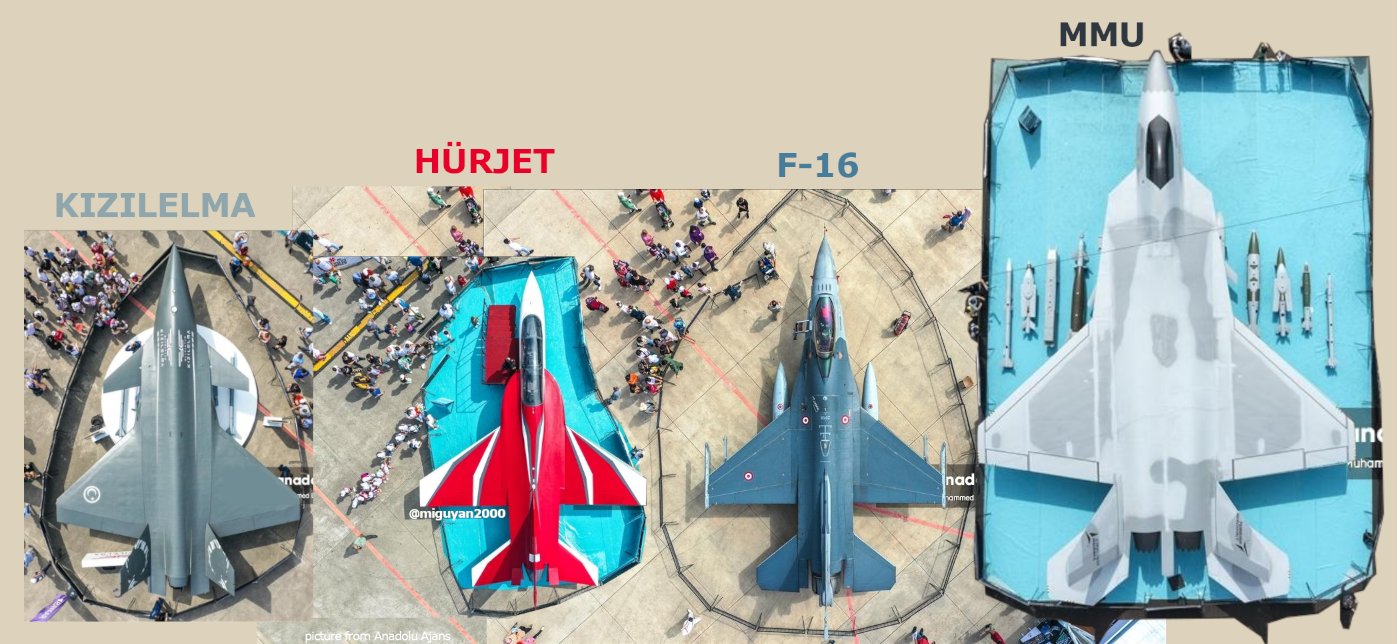
Now I understand what Mete Yarrar meant by 'MMU parts as large as an F-16 wing'.
If the models are scaled correctly I think they should go for F-110 class engine.
The latest design is on the same scale as an F-15E in terms of length and size. So it is in a way more like a stealthified F-15EX Eagle II than a Turkish F-22.If the models are scaled correctly I think they should go for F-110 class engine.
The latest design is on the same scale as an F-15E in terms of length and size. So it is in a way more like a stealthified F-15EX Eagle II than a Turkish F-22.
I was referring to kizilelma. It appears to be a F-16 sized bird based on the comparison image. I think using medium thrust engine would hold it back. Since Turkey has access for F-110 as a stopgap for MMU it shouldn’t be hard to get permission to use it on Kizilema as well. Using medium thrust engine will hold the airframe back.
Ignore the size. Focus on the weight. It's as light as a feather compared to conventional fighters. It's situated in between a Gripen and F-16 size wise, with half the MTOW of a Gripen. It can do fine with 3800lbf of the AI-25TLT as a groundattack/bomber aircraft but to be supermanouvrable, not more than 10000lbf is needed.F-16 sized
I predict the twin engined AI-322F variant will be as large as a twin engined heavy fighter while weighing half.
You should read my post above. It turns out that the TEI-TF-6000 engine was, among other applications, also developed for Kızılelma, and it is much more advanced and powerful than its counterparts.I was referring to kizilelma. It appears to be a F-16 sized bird based on the comparison image. I think using medium thrust engine would hold it back. Since Turkey has access for F-110 as a stopgap for MMU it shouldn’t be hard to get permission to use it on Kizilema as well. Using medium thrust engine will hold the airframe back.
Turkey Military News, Reports, Data, etc.
Turkey Military News, Reports, Data, etc.
As you said, I also think that a single Al-25 would limit Kızılelma's full potential.
F-110 would be too big and ineffective for a possible KE application. Instead, using two smaller sized engines would unlock its full potential, and that is what's going to happen anyways; Kızılelma is not only planned to have different engines but also a twin engined version.
Some specs for Kizilelma UCAV;
- Length; 14.7 meters
- Wingspan; 10 meters
- Height; 3.3 meters
- Cruise/Max Speed: 0.6/0.9 Mach
- Operational/Max Altitude; 35,000/45,000 feet
- Operational range: 500nm
- Useful load: 1,500kg
- Max Takeoff weight; 6,000kg
- Propulsion;
- 1xAI-25TLT
- 1xAI-322F
- 2xAI-322F (Confirming twin engine supersonic variant on the way)
- STOL and Carrier Landing Capability
Aside from that we shouldn't forget the fact that the KE is envisaged as a (relatively) cost effective platform, like as a jet engined, steathified TB-2; so to say. That is one of the important, if not the most important requirement(s) of it. Taking that away would significantly reduce its effectiveness.

